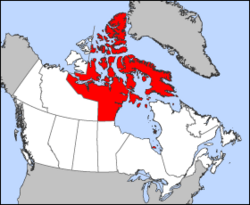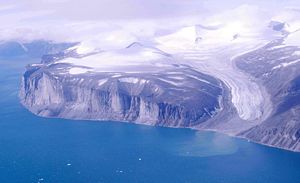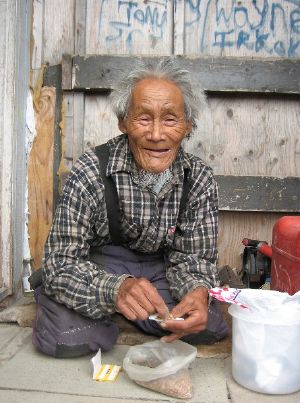Nunavut
| |||||
| Motto: Nunavut Sannginivut (Inuktitut: "Our land, our strength") | |||||

| |||||
| Capital | Iqaluit | ||||
|---|---|---|---|---|---|
| Largest city | Iqaluit | ||||
| Official languages | Inuktitut, Inuinnaqtun, English, French | ||||
| Government | |||||
| - Commissioner | Ann Meekitjuk Hanson | ||||
| - Premier | Paul Okalik (Consensus government) | ||||
| Federal representation | in Canadian Parliament | ||||
| - House seats | 1 (Nancy Karetak-Lindell) | ||||
| - Senate seats | 1 (Willie Adams) | ||||
| Confederation | April 1, 1999 (13th) | ||||
| Area [1] | Ranked 1st | ||||
| - Total | 2,093,190 km² (808,185 sq mi) | ||||
| - Land | 1,932,255 km² (746,048 sq mi) | ||||
| - Water (%) | 160,935 km² (62,137 sq mi) (7.7%) | ||||
| Population | Ranked 13th | ||||
| - Total (2008) | 31,142 (est.)[2] | ||||
| - Density | 0.015/km² (0/sq mi) | ||||
| GDP | Ranked 13th | ||||
| - Total (2006) | C$1.213 billion[3] | ||||
| - Per capita | C$39,383 (8th) | ||||
| Abbreviations | |||||
| - Postal | NU | ||||
| - ISO 3166-2 | CA-NU | ||||
| Time zone | UTC-5, UTC-6, UTC-7 | ||||
| Postal code prefix | X | ||||
| Flower | Purple Saxifrage | ||||
| Tree | N/A | ||||
| Bird | Rock Ptarmigan | ||||
| Web site | www.gov.nu.ca | ||||
| Rankings include all provinces and territories | |||||
Nunavut (IPA: /ˈnuːnəvʊt/) (Inuktitut syllabics: ![]() ) is the largest and newest territory of Canada; it was separated officially from the Northwest Territories on April 1 1999 via the Nunavut Act[4] and the Nunavut Land Claims Agreement Act,[5] though the actual boundaries were established in 1993. The creation of Nunavut resulted in the first major change to Canada's map since the incorporation of the new province of Newfoundland in 1949.
) is the largest and newest territory of Canada; it was separated officially from the Northwest Territories on April 1 1999 via the Nunavut Act[4] and the Nunavut Land Claims Agreement Act,[5] though the actual boundaries were established in 1993. The creation of Nunavut resulted in the first major change to Canada's map since the incorporation of the new province of Newfoundland in 1949.
The capital Iqaluit (formerly "Frobisher Bay") on Baffin Island, in the east, was chosen by the 1995 capital plebiscite. Other major communities include the regional centres of Rankin Inlet and Cambridge Bay. Nunavut also includes Ellesmere Island to the north, as well as the eastern and southern portions of Victoria Island in the west. Nunavut is both the least populated and the largest of the provinces and territories of Canada. It has a population of only 29,474[1] spread over an area the size of Western Europe. If Nunavut were a sovereign nation, it would be the least densely populated in the world: nearby Greenland, for example, has almost the same area and nearly twice the population.[6]
Nunavut means 'our land' in Inuktitut, the language of the Inuit. Its inhabitants are called Nunavummiut, singular Nunavummiuq.
Geography
The Territory covers about 1.9 million km² (750,000 sq mi) of land and 161,000 km² (62,000 sq mi) of water in Northern Canada including part of the mainland, most of the Arctic Archipelago, and all of the islands in Hudson Bay, James Bay, and Ungava Bay (including the Belcher Islands) which belonged to the Northwest Territories. This makes it the fifth largest subnational entity (or administrative division) in the world. If Nunavut were a country, it would rank 13th in area.[7] Nunavut has land borders with the Northwest Territories on several islands as well as the mainland, a border with Manitoba to the south of the Nunavut mainland, and a tiny land border with Newfoundland and Labrador on Killiniq Island. It also shares aquatic borders with the provinces of Quebec, Ontario and Manitoba and with Greenland.
The creation of Nunavut created Canada's only "four corners", at the intersection of the boundaries of Nunavut, the Northwest Territories, Manitoba, and Saskatchewan at , on the southern shore of Kasba Lake.[8] Nunavut's highest point is Barbeau Peak.
History
The region now known as Nunavut has supported a continuous population for approximately 4,000 years. Most historians also identify the coast of Baffin Island with the Helluland described in Norse sagas, so it is possible that the inhabitants of the region had occasional contact with Norse sailors.
- Further information: Dorset culture, Eskimo
The written history of Nunavut begins in 1576. Martin Frobisher, while leading an expedition to find the Northwest Passage, thought he had discovered gold ore around the body of water now known as Frobisher Bay on the coast of Baffin Island.[9] The ore turned out to be worthless, but Frobisher made the first recorded European contact with the Inuit. The contact was hostile, with both sides taking prisoners who subsequently perished.
Other explorers in search of the elusive Northwest Passage followed in the 17th century, including Henry Hudson, William Baffin and Robert Bylot.
In 1976 as part of the land claims negotiations between the Inuit Tapiriit Kanatami (then called the Inuit Tapirisat of Canada) and the federal government, the division of the Northwest Territories was discussed. On April 14, 1982, a plebiscite on division was held throughout the Northwest Territories with a majority of the residents voting in favour and the federal government gave a conditional agreement seven months later. The land claims agreement was decided in September 1992 and ratified by nearly 85% of the voters in Nunavut. On July 9 1993, the Nunavut Land Claims Agreement Act[5] and the Nunavut Act[4] were passed by the Canadian Parliament, and the transition was completed on April 1 1999.[10]
Demographics
| Municipality | 2006 | 2001 | growth |
|---|---|---|---|
| Iqaluit | 6,184 | 5,236 | 18.1% |
| Rankin Inlet | 2,358 | 2,177 | 8.3% |
| Arviat | 2,060 | 1,899 | 8.5% |
| Baker Lake | 1,728 | 1,507 | 14.7% |
| Igloolik | 1,538 | 1,286 | 19.6% |
| Cambridge Bay | 1,477 | 1,309 | 12.8% |
| Pangnirtung | 1,325 | 1,276 | 3.8% |
| Pond Inlet | 1,315 | 1,220 | 7.8% |
| Kugluktuk | 1,302 | 1,212 | 7.4% |
| Cape Dorset | 1,236 | 1,148 | 7.7% |
As of the 2006 Census the population of Nunavut was 29,474,[1] with 24,640 people identifying themselves as Inuit (83.6% of the total population), 100 as First Nations (0.34%), 130 Métis (0.44%) and 4,410 as non-aboriginal (14.96%).[11]
Language
Along with Inuktitut, Inuinnaqtun, English, and French are also official languages.
In his 2000 commissioned report (Aajiiqatigiingniq Language of Instruction Research Paper) to the Nunavut Department of Education, Ian Martin of York University states that a "long-term threat to Inuit language from English is found everywhere, and current school language policies and practices on language are contributing to that threat" if Nunavut schools follow the Northwest Territories model. He provides a 20 year language plan to create a "fully functional bilingual society, in Inuktitut and English" by 2020. The plan provides different models, including:
- "Qulliq Model," for most Nunavut communities, with Inuktitut as the main language of instruction.
- "Inuinnaqtun Immersion" model, for language reclamation and immersion to revitalize Inuinnaqtun as a living language.
- "Mixed Population Model," mainly for Iqaluit (possibly for Rankin Inlet), as the 40% Qallunaat population (pronounced "howl-u-naat" in the kivaliq region)("Qaa-loo-naat" by the Iqaluitmuit) the Inuit term for Caucasians, may have different requirements.[12]
The 2006 Canadian census showed a population of 29,474. Of the 29,025 singular responses to the census question concerning 'mother tongue' the most commonly reported languages were:
| 1. | Inuktitut | 20,185 | 69.54% |
| 2. | English | 7,765 | 26.75% |
| 3. | French | 370 | 1.27% |
| 4. | Inuinnaqtun | 295 | 1.02% |
There were also 260 responses of both English and a 'non-official language' (mainly Inuktitut); 20 of both French and a 'non-official language; 20 of both English and French; and about 140 people who either did not respond to the question, or reported multiple non-official languages, or else gave some other unenumerated response. Only English and French were counted as official languages in the census. Nunavut's official languages are shown in bold. Figures shown are for the number of single-language responses and the percentage of total single-language responses.[13]
Economy
- Lupin Mine - 1982-2005 - gold (located near the Northwest Territories boundary near Contwoyto Lake)[14]
- Polaris Mine - 1982-2002 - lead and zinc (located on Little Cornwallis Island, not far from Resolute)
- Nanisivik Mine at Nanisivik - 1976-2002 - lead and zinc (near Arctic Bay)
- Rankin Inlet Mine - 1957-1962 - nickel and copper
- Jericho Diamond Mine - 2006-present - diamond (located 400 km, 250 mi, northeast of Yellowknife)
Several mining projects are in the works; as of January 2006 Miramar Mining Corporation's Doris gold project and Cumberland Resources's Meadowbank gold project were in the process of review for approval.
Government
Nunavut's head of state is a Commissioner appointed by the federal Minister of Indian Affairs and Northern Development. As in the other territories, the commissioner's role is symbolic and is analogous to that of a Lieutenant Governor. While the Commissioner is not formally a representative of Canada's head of state, a role roughly analogous to representing The Crown has accrued to the position.
The members of the unicameral Legislative Assembly of Nunavut are elected individually; there are no parties and the legislature is consensus-based.[15] The head of government, the premier of Nunavut, is elected by, and from the members of the legislative assembly.
The territory's first legislature was dissolved on January 16 2004, with an election shortly thereafter. See Nunavut general election, 2004. As of 2007, Nunavut is in its second government.
Faced by criticism of his policies, Premier Paul Okalik set up an advisory council of eleven elders, whose function it is to help incorporate "Inuit Qaujimajatuqangit" (Inuit culture and traditional knowledge, often referred to in English as "IQ") into the territory's political and governmental decisions.
Owing to Nunavut's vast size, the stated goal of the territorial government has been to decentralize governance beyond the region's capital. Three regions—Kitikmeot, Kivalliq and Qikiqtaaluk/Baffin—are the basis for more localized administration, although they lack autonomous governments of their own.
The territory has an annual budget of C$700 million, provided almost entirely by the federal government. Former Prime Minister Paul Martin designated support for Northern Canada as one of his priorities for 2004, with an extra $500 million to be divided among the three territories.
In 2005, the government of Nunavut collaborated with the federal government and the technology firm SSI Micro to launch Qiniq, a unique network which uses satellite delivery to provide broadband Internet access to 25 communities in Nunavut. As a result, the territory was named one of the world's "Smart 21 Communities" in 2005 by the Intelligent Community Forum, a worldwide organization which honours innovation in broadband technologies.
In popular culture
Three Dead Trolls in a Baggie wrote a song about the birth of this territory. The theme of the song is along the lines of "We'll keep Canada," he said, "and you can have Nunavut!" (pronouncing it "None-of-it").
Susan Aglukark is an Inuit singer and song writer. She has released 6 albums and has won several Juno Awards. She blends the Inuktitut and English languages with contemporary pop music arrangements to tell the stories of her people, the Inuit of Arctic.
On May 3, 2008, the Kronos Quartet premiered a collaborative piece with Inuit throat singer Tanya Tagaq entitled Nunavut which makes use of an Inuit folk story.
The Nunavut licence plate, originally created for the Northwest Territories in the 1970s, which is shaped like a polar bear, has long been famous worldwide for its unique design. Nunavut opted to use the same plate design in 1999 when it became a separate territory.
Notes
- ↑ 1.0 1.1 1.2 Statistics Canada (2006). Community Highlights for Nunavut. Retrieved 2008-01-16.
- ↑ Statistics Canada. Canada's population estimates 2008-03-27. Retrieved 2008-04-05.
- ↑ Gross domestic product, expenditure-based, by province and territory
- ↑ 4.0 4.1 Justice Canada (1993). Nunavut Act. Retrieved 2007-04-26.
- ↑ 5.0 5.1 Justice Canada (1993). Nunavut Land Claims Agreement Act. Retrieved 2007-04-26.
- ↑ CIA World Factbook
- ↑ Wikipedia contributors, "List of countries and outlying territories by total area," Wikipedia, The Free Encyclopedia, (accessed May 9, 2007).
- ↑ The Corner Corner. Manitoba - Northwest Territories - Nunavut - Saskatchewan Multi-point. Retrieved 2007-04-26.
- ↑ Maple Leaf Web: Nunavut - The Story of Canada's Inuit People
- ↑ CBC Digital Archives (2006). Creation of Nunavut. Retrieved 2007-04-26.
- ↑ Statistics Canada (2006). 2006 Census Aboriginal Population Profiles. Retrieved 2008-01-16.
- ↑ Board of Education (2000). "Summary of Aajiiqatigiingniq". gov.nu.ca. Retrieved 2007-10-27.
- ↑ Detailed Mother Tongue (186), Knowledge of Official Languages (5), Age Groups (17A) (3) (2006 Census)
- ↑ Wolfden Resources
- ↑ CBC Digital Archives (2006). On the Nunavut Campaign Trail. Retrieved 2007-04-26.
ReferencesISBN links support NWE through referral fees
- Alia, Valerie. Names and Nunavut Culture and Identity in Arctic Canada. New York: Berghahn Books, 2007. ISBN 1845451651
- Henderson, Ailsa Nunavut: Rethinking Political Culture. Vancouver: University of British Columbia Press, 2007. ISBN 0774814233
- Kulchyski, Peter Keith. Like the Sound of a Drum: Aboriginal Cultural Politics in Denendeh and Nunavut. Winnipeg: University of Manitoba Press, 2005. ISBN 0887551785
- Sanna, Ellyn, and William Hunter. Canada's Modern-Day Aboriginal Peoples Nunavut & Evolving Relationships. Markham, Ont: Scholastic Canada, 2008. ISBN 9780779173228
| ||||||||||
External links
All links Retrieved May 11, 2008.
NEED TO BE CHECKED:
- Map showing regions of Nunavut (from Nunavut Government website)
- Legislative Assembly of Nunavut
- Nunavut Kavamat / Government of Nunavut: Official site
- Nunavut Planning Commission
- Nunavut Tunngavik Inc.: Nunavut Land Claims website
- The Nunavut Act of 1993 at Canadian Legal Information Institute
- Nunavut K-12 bilingual language instruction plan: Martin, Ian. Aajiiqatigiingniq Language of Instruction Research Paper. Nunavut: Dept. of Education, 2000.
- Official web site of Susan Aglukark - Inuit singer/songwriter
Tourism
Journalism
- CBC North Radio: hear Inuktitut and English radio from Nunavut
- Territorial newspaper reporting in Inuktitut and English
Credits
New World Encyclopedia writers and editors rewrote and completed the Wikipedia article in accordance with New World Encyclopedia standards. This article abides by terms of the Creative Commons CC-by-sa 3.0 License (CC-by-sa), which may be used and disseminated with proper attribution. Credit is due under the terms of this license that can reference both the New World Encyclopedia contributors and the selfless volunteer contributors of the Wikimedia Foundation. To cite this article click here for a list of acceptable citing formats.The history of earlier contributions by wikipedians is accessible to researchers here:
The history of this article since it was imported to New World Encyclopedia:
Note: Some restrictions may apply to use of individual images which are separately licensed.



